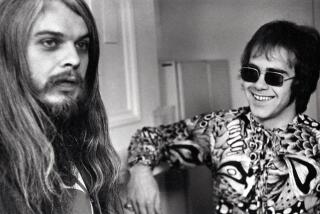Writer chronicled sagas of sports, war
W.C. Heinz, a sportswriter and novelist who profiled champions and contenders with unvarnished precision, died Wednesday at an assisted-care facility in Bennington, Vt. He was 93. The cause was complications from old age, his daughter, Gayl Heinz, said.
“Heinz was the best,” former newspaper columnist Jimmy Breslin told The Times on Wednesday. His sports writing was “supreme, untouchable,” Breslin said.
Over a 50-year career, Heinz wrote novels and short stories as well as newspaper columns and magazine features, but even his fiction grew out of his skills as a reporter. He was drawn to every form of professional combat, from the battlefields of war to major league sports. Boxing was the metaphor for life’s brutal contests that most captured his imagination.
He developed a technique that took him behind the scenes of a story, where he could observe his subjects at close range and capture their natural speech. It was an approach made popular some years later by the “new journalism” writers of the 1960s, particularly Tom Wolfe and Gay Talese.
Heinz, however, made a point of keeping himself out of his stories, which set his work apart from new journalism.
“The writer should be invisible,” he said. “Listen for the way each person speaks,” he advised. “And get that down on paper.”
Wilfred Charles Heinz signed only his initials but was known as Bill. He began his newspaper career in the late 1930s at the now-defunct New York Sun newspaper in Manhattan.
Most fans consider his feature articles and his first novel, “The Professional” (1958), required reading. In the novel, he follows a middleweight prizefighter through training. The story grew out of years spent ringside at Stillman’s Gym on 8th Avenue in Manhattan. Ernest Hemingway and Elmore Leonard both sent Heinz fan mail after they read the book. Hemingway called it “the only good novel about a fighter I’ve ever read and an excellent first novel in its own right.”
For Leonard, it became a model. “I was studying writing closely in the ‘50s, and I learned a lot from Heinz,” Leonard recently told The Times. He followed Heinz’s magazine profiles. “Heinz got so much dialogue into his writing. He could get sports guys to talk, and he’d get their attitude right.”
Uninterrupted dialogue is a hallmark of the Heinz style. In “The Professional,” a reporter asks the contender why he goes into the ring.
“How come you like boxing so much?”
“Because I find so much in it.”
“How do you mean?”
“The basic law of man. The truth of life. It’s a fight, man against man, and if you’re going to defeat another man, defeat him completely. Don’t starve him to death, like they try to do in the fine, clean competitive world of commerce. Leave him lying there, senseless, on the floor.”
Another of Heinz’s most popular books is “Run to Daylight!” -- written in 1963 with Green Bay Packers coach Vince Lombardi. Heinz lived at the coach’s house for two weeks as part of his research, and the book came out just as Lombardi was rocketing to fame. By the end of the decade he had led the Packers to a pair of Super Bowl victories. The book reads like a diary -- taut and immediate because it is written in the present tense in Lombardi’s voice.
“When they come back, the roar from the stands is beating down in waves around us and I am in the middle, crouching, with the squad pressing in around me.
“ ‘So we all know what this means,’ I am saying. ‘We all know what it means. We know we’ve got to go out there and hit. So let’s do it. Let’s take it to them. Let’s go.’
“They break then, with their exclamations, and our kickoff-receiving team runs out to my right. From the other sideline the other team is peeling out of its huddle. And now that nervousness which I have forestalled, which I have learned to control up to a point, starts to come.
“And don’t let’s drop this kickoff, I’m thinking. This is it now, and please let’s not fumble this. Please let’s not give them anything they don’t deserve.”
While a sports reporter at the Sun from the mid-1940s to 1950, when the newspaper folded, Heinz wrote a column, “The Sport Scene,” five days a week for two years. He was widely considered the equal of his better-known colleague and close friend, Red Smith of the Herald Tribune, who later went to the New York Times.
It is the medical novel “MASH,” however, that introduced Heinz’s vivid prose to a wider audience. He co-wrote the book in 1968 with H. Richard Hornberger, who used the pseudonym Richard Hooker. Referring to one of the novel’s main characters, Heinz said, “I’d write ‘Hot Lips’ in the text and apologize to my typewriter. Sorry, I have to make a living.”
Heinz was born Jan. 11, 1915, in Mount Vernon, N.Y., the only child of a salesman. He liked to read as much as he liked sports. He could carry his own in conversations about the plays of Shakespeare or the poetry of Tennyson as easily as he could discuss hockey, the sport he played all through high school.
At Middlebury College in Vermont he edited the sports pages of the school newspaper and met his future wife, Elizabeth Bailey. He graduated in 1937 with a bachelor’s degree in political science and worked for several years as a general assignment reporter at the Sun. In 1943 he was made a junior war correspondent. During World War II he followed the Allied Forces across Europe from Normandy toward Berlin.
“I learned to write during the war,” Heinz later said. “The material was so rich you had great opportunity. The trick was to under-write.”
His favorite memory from those years was meeting Hemingway, his literary idol, who was writing magazine articles about the war and staying in a house in the Rhineland. Heinz went to visit and took a bottle of good Scotch, which sealed their friendship. When “The Professional” was published, critics noted a definite Hemingway influence.
Home from Europe in 1945, Heinz was assigned the sports beat and quickly drew attention. Damon Runyan, the popular journalist and author, was asked to recommend someone for a magazine job. Runyan, who had been silenced by throat cancer, wrote his answer on a cocktail napkin. “W.C. Heinz is very good.” He underlined “very good” three times.
When the Sun closed its doors, Heinz gave up other offers to become a freelance writer. In 1951, his first year on his own, he wrote “Brownsville Bum.”
Breslin considered it “the best sports magazine piece of all times.” It remains one of Heinz’s most admired features and has been reprinted in several anthologies over the years, including “What a Time It Was: The Best of W.C. Heinz on Sports” (2001).
He profiles Al “Bummy” Davis, a talented boxer who couldn’t keep out of trouble.
Journalists still refer to the opening lines as a shining example of what feature news writing can be. The second paragraph tells the tale:
“The night Bummy fought Fritzie Zivic in the Garden and Zivic started giving him the business and Bummy hit Zivic low maybe 30 times and kicked the referee, they wanted to hang him for it. The night those four guys came into Dudy’s bar and tried the same thing, only with rods, Bummy went nuts again. He flattened the first one, and then they shot him, and when everybody read about it, and how Bummy fought guns with only his left hook and died lying in the rain in front of the place, they all said that was really something and you sure had to give him credit for it.”
Heinz supported his wife and two daughters on a freelancer’s income after the family moved from Manhattan to Connecticut.
His life changed in 1964 when his oldest daughter Barbara, 16, died of a virulent illness. Heinz and his wife lived apart for a time and did their grieving alone. He went back to New York and took an apartment on 8th Avenue in the former location of his old haunt, Stillman’s Gym.
He and his wife slowly got back together and settled in Dorset, Vt., close to where their daughter’s ashes were scattered. She had spent a happy summer at a summer camp there.
He wrote “MASH” as well as a second medical novel, “Emergency.” He published several collections of his feature articles including “Once They Heard the Cheers” in 1979.
When his wife developed Alzheimer’s disease, Heinz took care of her until her death in August 2002. They had been married 61 years.
Reporters continued to make pilgrimages to meet him after he moved to a nursing home. Writing had become the sport that he, at 87, loved best.
“A good writer is like a good fighter,” Heinz said. “You keep your reader in front of you, moving him around. You want to keep the reader on his toes, wondering what comes next.”
In addition to his daughter Gayl, Heinz is survived by granddaughter Kristina Pantalone; both live in Amesbury, Mass.
Contributions in his name can be made to the Residents Fund, Vermont Veterans Home, 325 North St., Bennington, VT 05201.
--
More to Read
Sign up for our Book Club newsletter
Get the latest news, events and more from the Los Angeles Times Book Club, and help us get L.A. reading and talking.
You may occasionally receive promotional content from the Los Angeles Times.






